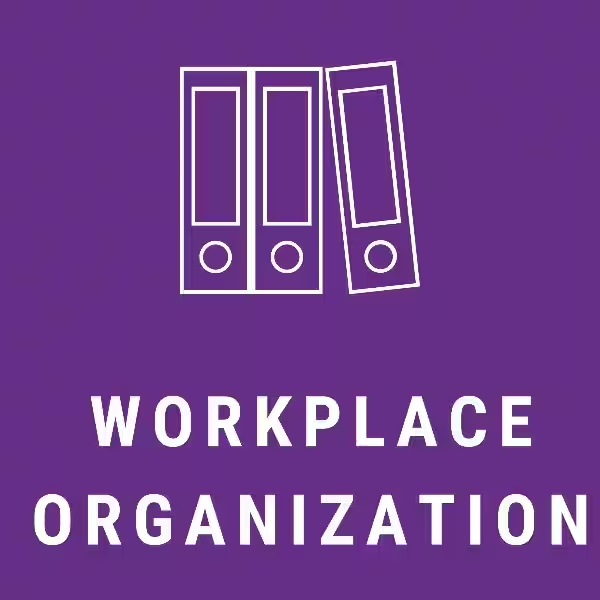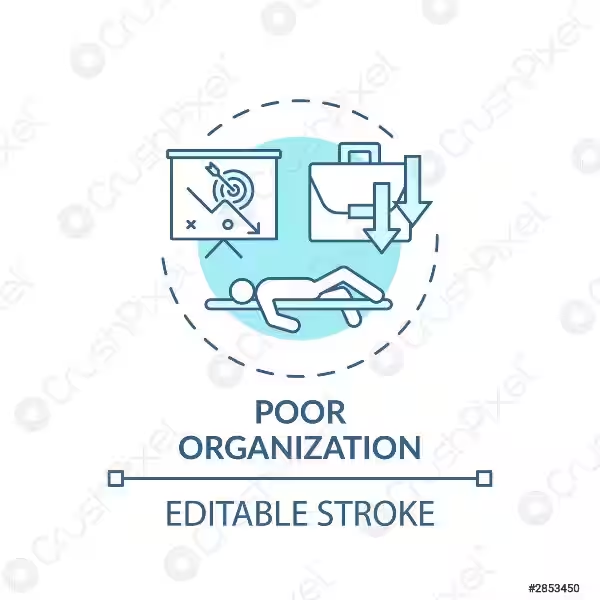Achieving Peak Productivity: Mastering Workplace Organization

Workplace organization isn't just about tidiness; it's the cornerstone of efficiency, safety, and employee well-being. A well-organized workspace fosters a productive environment, reducing wasted time searching for tools or information and minimizing errors caused by clutter and disorganization. But how do you achieve this ideal state? This article explores various methodologies and practical strategies to transform your workplace into a smoothly functioning, productive powerhouse.
Understanding the Foundational Principles of Workplace Organization
Effective workplace organization isn't a one-size-fits-all solution. It requires a holistic approach that considers both the physical space and the underlying processes. Many successful strategies focus on reducing waste, improving workflow, and empowering employees to work more efficiently and safely. This often involves a commitment to continuous improvement, where processes are regularly evaluated and refined.
The benefits extend beyond mere efficiency. A well-organized workplace contributes to improved employee morale, reduced stress, and a safer work environment. When employees can easily find what they need and work in a clean, uncluttered space, their productivity increases, and their job satisfaction improves. This translates to a more positive and productive work culture overall.
Lean Manufacturing and Six Sigma: Improving Processes for Optimal Organization
Lean manufacturing and Six Sigma are powerful methodologies focusing on eliminating waste and reducing variation in processes. Lean, inspired by Toyota's production system, aims to streamline workflows by identifying and eliminating activities that don't add value. Six Sigma, a data-driven approach, strives to reduce defects and improve quality through process optimization. Both methodologies heavily emphasize workplace organization as a crucial component of success.
Implementing these methodologies often involves the creation of standard work, which documents best practices for every task, ensuring consistency and providing a baseline for improvement. This documentation includes details of workplace organization, like equipment placement and material storage, creating a standardized and efficient work environment. The integration of these methodologies requires a commitment to data-driven decision-making and continuous improvement.
The Power of 5S: A Step-by-Step Guide to Workplace Organization
The 5S methodology, a cornerstone of lean manufacturing and a popular workplace organization technique, is a five-step process designed to create a clean, organized, and efficient work environment. It's more than just a cleaning program; it's a visual management system that makes problems readily apparent. The five steps are:
- Sort (Seiri): Eliminate unnecessary items. Identify everything in the workspace and remove anything that isn't essential for daily operations.
- Set in Order (Seiton): Organize remaining items for easy access and efficient workflow. This involves clearly labeling everything and storing items in designated locations.
- Shine (Seiso): Clean the workspace regularly to prevent the accumulation of dirt, waste, and hazards. This step promotes a safe and healthy work environment.
- Standardize (Seiketsu): Establish clear procedures and standards for maintaining the organization and cleanliness of the workspace. This ensures consistency and prevents backsliding.
- Sustain (Shitsuke): Implement ongoing audits and feedback mechanisms to ensure the system's effectiveness and identify areas for further improvement. This step is crucial for long-term success.
Implementing 5S successfully requires commitment from everyone in the workplace. It's not a one-time project but an ongoing process of continuous improvement. The benefits include improved safety, increased efficiency, reduced waste, and a more positive work environment.
Beyond 5S: Other Effective Workplace Organization Techniques
While 5S provides a strong foundation for workplace organization, many other techniques can further enhance productivity and efficiency. These include:
- Gemba Walks: Management visits the worksite to observe processes firsthand, identify problems, and engage with employees.
- Kanban: Uses visual cues to manage workflow and minimize inventory.
- Value Stream Mapping (VSM): Visualizes the flow of materials and work, identifying bottlenecks and areas for improvement.
- A3 Problem Solving: A structured approach to problem-solving, encouraging collaborative problem solving and documentation.
- DMAIC (Define, Measure, Analyze, Improve, Control) and PDSA (Plan, Do, Study, Act): These improvement cycles use data-driven approaches to refine processes continually.
These techniques often rely on data-driven decisions, teamwork, and a commitment to continuous improvement. They complement 5S by providing a structured framework for addressing specific challenges and optimizing processes. Many organizations combine these methods to create a comprehensive workplace organization strategy.
The Importance of Sustaining Workplace Organization
Implementing new workplace organization strategies is only half the battle; maintaining them is equally crucial. Sustaining improvements requires ongoing effort, commitment, and regular audits. This involves establishing clear standards, providing training, and fostering a culture of continuous improvement. Regular inspections and feedback mechanisms are essential to identify areas needing attention and to prevent the gradual decline into disorganization. Workplace organization, when effectively implemented and sustained, becomes an integral part of the organizational culture, driving efficiency and productivity consistently. Neglecting this step can lead to a return to inefficient practices and the loss of the initial benefits. Consistent effort and a commitment to the principles of workplace organization are key to long-term success.
Workplace Organization FAQ
What is workplace organization, and why is it important?
Workplace organization encompasses the systematic arrangement of physical and digital spaces to optimize efficiency, safety, and productivity. It's not just about tidiness; it's a strategic approach to minimizing waste, improving workflow, and fostering a more positive and productive work environment. A well-organized workspace reduces errors, improves access to tools and information, and contributes to a safer and more efficient operation. Ultimately, it supports continuous improvement and boosts employee morale.
What are some key methodologies for improving workplace organization?
Several methodologies contribute to effective workplace organization. These include:
-
5S: A five-step process (Sort, Set in Order, Shine, Standardize, Sustain) for systematically organizing and maintaining a clean and efficient workspace. This is a foundational approach addressing both physical and digital clutter.
-
Lean and Six Sigma: These methodologies focus on eliminating waste and reducing variations in processes, contributing to a more streamlined and organized workflow. They often incorporate aspects of 5S and other organizational techniques.
-
Kanban: A visual system for managing workflow, minimizing inventory, and promoting efficient task completion. This approach is particularly useful for managing tasks and projects effectively.
-
Value Stream Mapping (VSM): A tool for visualizing the flow of materials and work, identifying bottlenecks and areas for improvement in processes, leading to better organization and efficiency.
-
A3 Problem Solving: A structured approach for documenting and resolving workplace issues, contributing to a more organized approach to problem-solving and continuous improvement.
How does the 5S methodology work in practice?
5S is a practical, step-by-step approach:
-
Sort: Identify and remove unnecessary items, keeping only essential tools and materials.
-
Set in Order (Straighten): Arrange remaining items logically and efficiently, ensuring easy access and retrieval. Labeling is crucial for clarity.
-
Shine: Regularly clean and maintain the workspace, removing dirt, debris, and unnecessary items to prevent build-up and maintain a safe environment.
-
Standardize: Establish clear rules and procedures for maintaining organization, ensuring consistency and preventing backsliding.
-
Sustain: Implement ongoing checks and feedback mechanisms to ensure the system's effectiveness and address any issues that arise. This is crucial for maintaining long-term gains.
What are the benefits of a well-organized workplace?
A well-organized workplace offers numerous benefits, including:
-
Increased Efficiency: Streamlined workflows and easy access to tools and information lead to faster task completion.
-
Improved Safety: A clean and organized environment reduces the risk of accidents and injuries.
-
Reduced Errors: Clear processes and well-organized materials minimize mistakes and improve quality.
-
Enhanced Morale: A clean and efficient workspace contributes to a more positive and productive work environment, boosting employee morale.
-
Cost Savings: Reduced waste, improved efficiency, and fewer errors translate to significant cost savings.
-
Better Problem Solving: A structured environment facilitates easier problem identification and resolution.
How can I implement workplace organization improvements in my workplace?
Start by identifying areas needing improvement. Choose one methodology, such as 5S, and implement it gradually, focusing on one area at a time. Engage employees in the process, providing training and support. Regular audits and feedback mechanisms are essential for maintaining improvements. Remember, continuous improvement requires ongoing effort and commitment. Data tracking can help you measure the effectiveness of your changes and support data-driven decisions for further enhancements.








